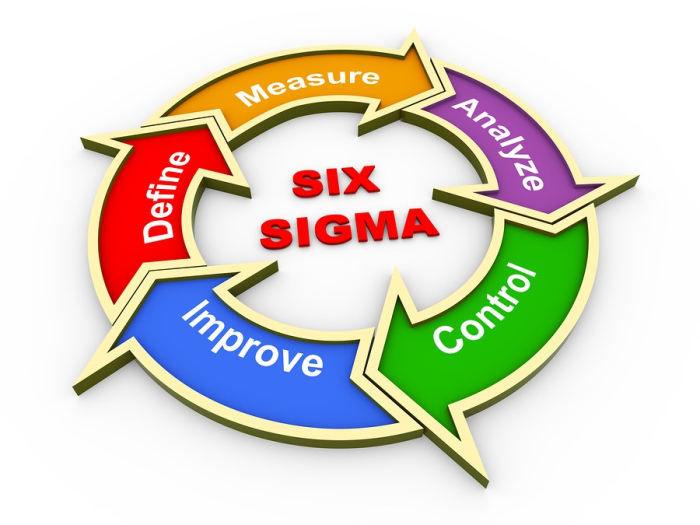
 Data Structure
Data Structure Networking
Networking RDBMS
RDBMS Operating System
Operating System Java
Java MS Excel
MS Excel iOS
iOS HTML
HTML CSS
CSS Android
Android Python
Python C Programming
C Programming C++
C++ C#
C# MongoDB
MongoDB MySQL
MySQL Javascript
Javascript PHP
PHP
- Selected Reading
- UPSC IAS Exams Notes
- Developer's Best Practices
- Questions and Answers
- Effective Resume Writing
- HR Interview Questions
- Computer Glossary
- Who is Who
The Six Sigma Process Explained and Tips to Start Implementing It Today
If you're an entrepreneur or business owner, you know that achieving success requires continuous improvement. And that's where Six Sigma comes in ? Six Sigma is one of the world's most popular and successful quality management systems.
It's a process that helps businesses reduce variation and improve quality across their entire supply chain. It involves a series of steps that can be applied in any organization, but depending on your needs, you may want to customize it slightly.

What is Six Sigma?
Six Sigma is a process of continuous improvement. It's a way to eliminate defects, improve quality and reduce variability in your business processes. It is all about the "why" rather than the "how" when implementing this new methodology into your company. The goal is to improve productivity and customer satisfaction through increased customer loyalty.
Six Sigma can help businesses improve efficiency, product quality, customer satisfaction, worker morale, etc. Reducing the amount of variation in an operation or process allows companies to make more accurate decisions quickly and efficiently. This can lead to increased profits and shorter service cycle times.
What is the Six Sigma process?
Six Sigma is an approach to quality management that focuses on reducing variation and improving production speed, accuracy, and efficiency. It is a systematic process for achieving these goals by applying statistical methods to improve the quality of products or services.
The Six Sigma process is a quality management system that helps businesses achieve improved performance and lower costs. The Six Sigma process aims to reduce variability in product output, thereby improving customer satisfaction and preventing business failures.

The six sigma process has five phases ?
Define
Measure
Analyze
Improve
Control
These phases are also known as the DMAIC methodology. Let us understand them one by one ?
The Six Sigma Process Explained: DMAIC
The Six Sigma Process is a five?step process that helps businesses to achieve success through Quality Control. DMAIC (Define, Measure, Analyze, Improve, and Control) is a quality control methodology that focuses on reducing variation and improving the process to be repeatable.
By using DMAIC, businesses can improve their efficiency and accuracy while also controlling costs. Defining the tasks to be completed allows for accurate progress tracking and ensures that no task is skipped or left undone.
Define ? Problem definition is the first step in DMAIC Six Sigma. It helps to identify and define your business or process's challenges, so you can begin to find solutions. Defining problems allows you to pinpoint where defects may occur and give you a baseline for measuring progress.
Measure ? The second step in DMAIC Six Sigma is to measure and manage the process variation. This means that you need to track how your processes are performing and identify any changes that might be necessary. This can involve using various methods, such as surveys, performance measurements, or checklists. Once you have identified any issues or changes, you can take appropriate action to fix them. Tracking your process variations and taking corrective action when needed will ensure that your processes remain consistent and reliable throughout the entire lifecycle.
Analyze ? In order to improve the quality of a process or product, it is necessary first to identify and analyze the issues. The third step in DMAIC is essential for this purpose. During the Analyze phase, you will implement solutions that address identified issues. This may involve modifying existing procedures or implementing new technology solutions, such as software development cycles that are more effective at completing tasks on time or tracking system errors effectively.
Improve ? Improvement is the fourth step in DMAIC six sigma. The improvement consists of creating a plan to improve an area, setting goals for improvement, implementing the chosen plan, and monitoring results. The benefits of improving your work performance through improved methods include increased efficiency, reduced waste, and increased satisfaction with work.
Control ? To succeed in any type of organization, it is essential to have control. This means having the ability to make decisions and implement them quickly and effectively. Keep an eye on changes in the environment surrounding your control system ? if anything new occurs that could potentially affect its performance, take appropriate action quickly!
How do you start using the Six Sigma approach?
The Six Sigma technique depends on the specific needs of your business or project. However, here are some tips that may help you get started ?
Understand what quality management is and why it's important ? Quality management refers to a systematic approach to delivering products or services that meet customer expectations and comply with applicable regulations. By understanding the benefits of quality management, you'll be better able to understand how Six Sigma can help your team achieve its goals.
Map out your process ? Before starting any interventions, it's important to understand every step ? from purchasing materials through manufacturing and delivery processes to customer service channels.
Create a plan for improvement ? Once you have a good grasp of your current process, begin developing proposals for improvements ? these could involve changes at any system level.
By following these simple steps, you will be well on your way toward implementing Six Sigma into your business or project!
Tips to Start Implementing it Today
Before you can start implementing Six Sigma, there are a few things to consider.
Six Sigma is a process management approach that eliminates process variation and reduces defects. Processes must be designed to meet customer needs while maintaining quality standards. Most importantly, you'll need to have the right team members and tools in place. You also need to understand how your organization operates and what metrics can be used for decision?making.
There are many ways businesses can start implementing six sigma, but some of the most common steps include ?
Creating an effective strategy ? The first step in any Six Sigma implementation is establishing a clear goal and objectives for the project. This will help you prioritize resources and determine what actions need to be taken to reach your goals.
Measuring progress ? To ensure that your efforts are progressing as intended, it's important always to measure results. You should track both qualitative and quantitative data throughout the project timeline.
Improving process design ? Once you understand how your processes work, it's time to improve their design. Properly structured processes will minimize variability while still meeting customer expectations.
Conclusion
After reading all these steps, we are sure that you will definitely want to start implementing Six Sigma in your business or at least know what it entails.
The main idea behind Six Sigma is to find the root cause of problems and make improvements step?by?step. You just need a proper framework for analytics and an open mind to change your behaviors for success!

